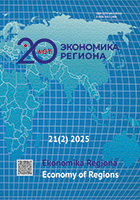The Role of Housing Development in Population Shifts During Migration (the Case of Moscow and Moscow Oblast, Russia)
DOI:
https://doi.org/10.17059/ekon.reg.2025-2-5Keywords:
mobile operators’ data, Moscow agglomeration, foreign migrants, internal migrants, housing construction, spatial structureAbstract
This study uncovers how the rise of large new residential complexes is reshaping the size and makeup of urban populations—an important yet often overlooked connection. Employing statistical and cartographic methods, we analysed comprehensive data on the localization of cellular subscribers from all mobile operators for October 2021 and 2023, alongside housing construction data from 2021–2022. Our methodological approach quantitatively assesses the impact of new residential development and subsequent settlement on structural, demographic, and ethnocultural transformations in urban spaces, focusing on shifts among native residents of Moscow Oblast, internal migrants, and foreign migrants. The findings reveal that new housing construction is the primary driver of population growth in New Moscow and Moscow Oblast. In contrast, in Old Moscow, new housing is only one of several factors influencing population change, meaning that housing commissioning does not always correspond with an increase in residents. Migration patterns were also examined: internal migrants predominantly settle in more affordable new housing in New Moscow, where they can comprise up to one-third of the population, while in Old Moscow, they tend to occupy older housing stock. New residential complexes also show a high concentration of foreign migrants, even during construction, due to the attraction of migrant labour. Furthermore, different factors influencing migrant concentrations in new housing vary across areas of the metropolitan region. These results offer valuable insights for territorial and sectoral planning of Moscow and Moscow Oblast. Additionally, the study provides a methodological foundation for future research that will benefit from expanding spatial and temporal data coverage from mobile operators in Russia and the availability of longer time series.
Downloads
Published
How to Cite
Issue
Section
License
Copyright (c) 2025 Svetlana Badina, Roman Babkin, Alexander Bereznyatskiy

This work is licensed under a Creative Commons Attribution 4.0 International License.




